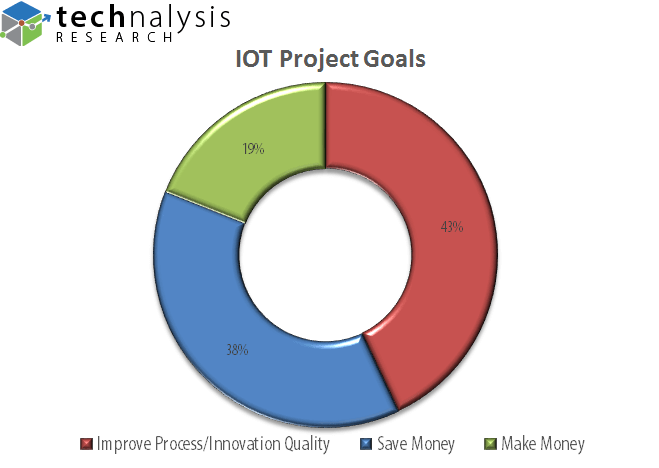
It was supposed to be about the money. Primarily saving it, but possibly even making some. In the real world, however, it turns out that process and innovation trump the dollar when it comes to the use of IoT-related technologies in business.
In fact, according to a survey of 620 IoT (Internet of Things) professionals from medium- and large-sized businesses throughout the US, conducted by TECHnalysis Research, the primary goal of their company’s IoT efforts in 43% of the cases was “Improving Processes/Innovation”, versus 38% for Saving Money and 19% for Making Money.
The chart below highlights the results.

This is somewhat surprising for those who focus on IoT in business because the vast majority of the discussion on this topic to date has been about cost savings. The theory was/is that investments in connected machines, sensor-driven networks, and other IoT-type projects would directly translate into dollar savings for enterprises who chose to deploy them.
Now, arguably, improving process quality and helping an organization become more innovative ultimately does drive dollars to the bottom line. The path to those savings, however, is much more indirect. Plus, it’s often a rather circuitous one.
As a result, while there continues to be great expectations around the potential IoT can have in business, the promise isn’t always living up to the hype. To be fair, there are companies who have successfully installed IoT-based projects and are already driving both monetary and process improvements in their organizations.
These successes, as with many major technology-driven initiatives in medium- and large-sized companies, typically occur in enterprises that have high-level managerial champions. These are individuals who understand the long-term opportunities of the technology and are willing to help push past the inevitable short-term challenges.
For many companies, however, the complexity of the topic and the typically indirect nature of the savings is currently making the footing through the technological marshlands of IoT a bit treacherous.
Fundamentally, enterprise IoT is about business process transformation. It’s about refining or rethinking how tasks are done in an organization and leveraging a variety of new technologies—from sensors to low-power connectivity to advanced analytics software—in order to make the end results better and/or more cost-effective. In some cases, it’s about creating new processes that weren’t previously possible, to gain new insights into how certain elements of a business currently or could potentially run.
Fundamentally, enterprise IoT is about business process transformation. It’s also pretty complicated, if we’re honest about it.
It’s also pretty complicated, if we’re honest about it. It’s complicated to talk about, it’s challenging to design and deploy, it’s hard to write about, and it’s difficult to sell, both within an organization and from one business to another. This is in large part why the impact of IoT has been somewhat limited to date. Sure, the promise of it seems straightforward, but the actual real world installations are taking longer, costing more and generally proving to be much more difficult than many people previously expected.
As one respondent to the survey describing his or her company’s current IoT efforts aptly put it, “Massive push back from workforce at every level, hard to implement, harder still to display positive signs of effectiveness. Acclimation time is probably three times the expected norm.”
Despite these challenges, however, there are still very promising signs. Already, organizations who are deploying IoT have started an average of 5.1 different projects and are potentially considering another 2.8 more. You don’t provide that level of commitment if you don’t think a real opportunity is there.
As another survey respondent wrote, “Our company has really embraced IOT and [it] has paid real dividends to cost savings and the effectiveness of our staff. It has been an incredible asset and as we continue to add IOT through more sectors of our operation, we are excited for the future.”
No business takes the concept of transformation lightly and no business can realistically expect transformative changes to occur overnight. In the case of enterprise IoT, the key seems to be putting more focus on process and indirect savings, and a bit less on immediate payback.
(You can find out more about the TECHnalysis Research Enterprise IOT Study here.)
Bob O’Donnell is the founder and chief analyst of TECHnalysis Research, LLC a technology consulting and market research firm. You can follow him on Twitter @bobodtech. This article was originally published on Tech.pinions.
https://www.techspot.com/news/64495-enterprise-iot-drives-indirect-savings.html